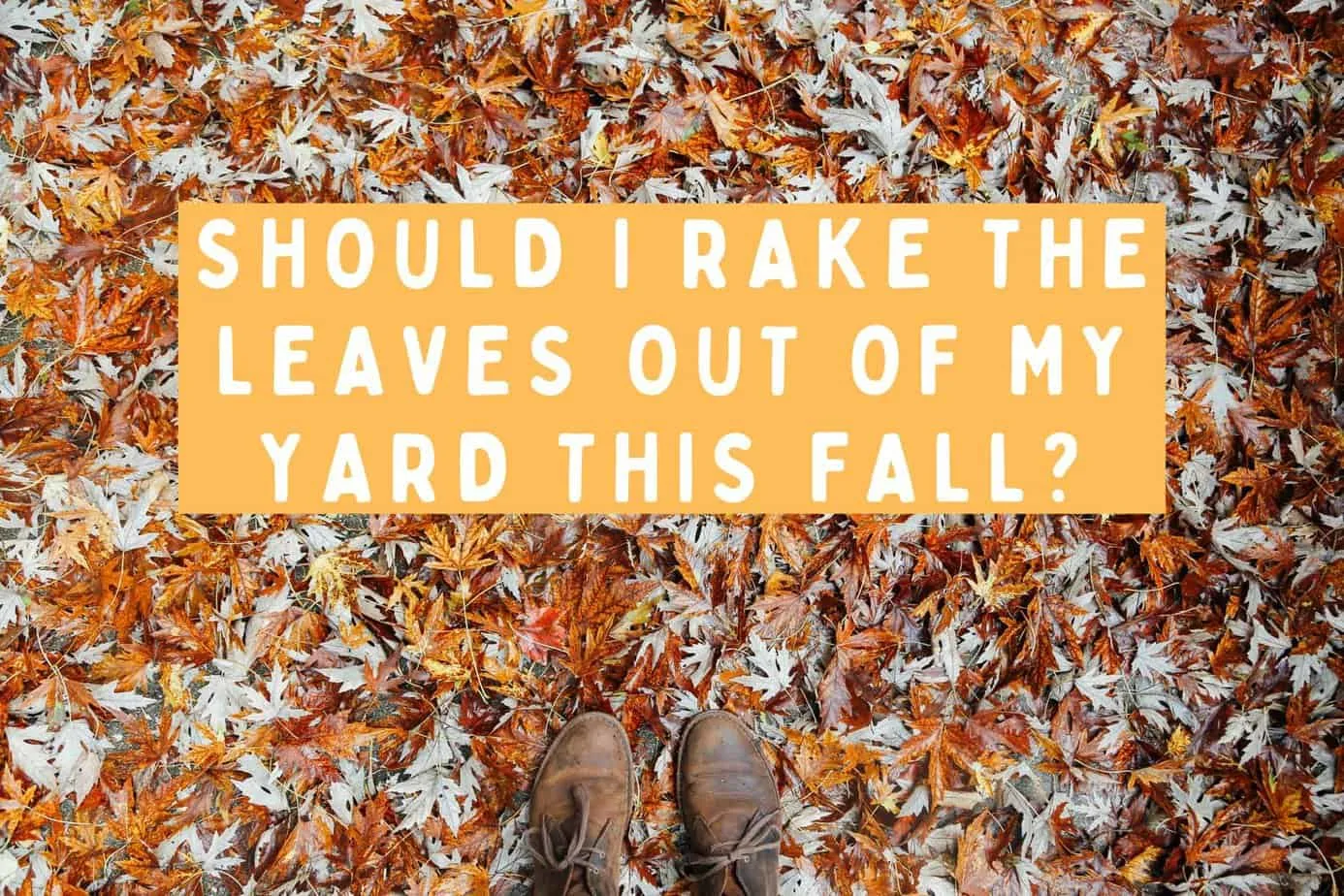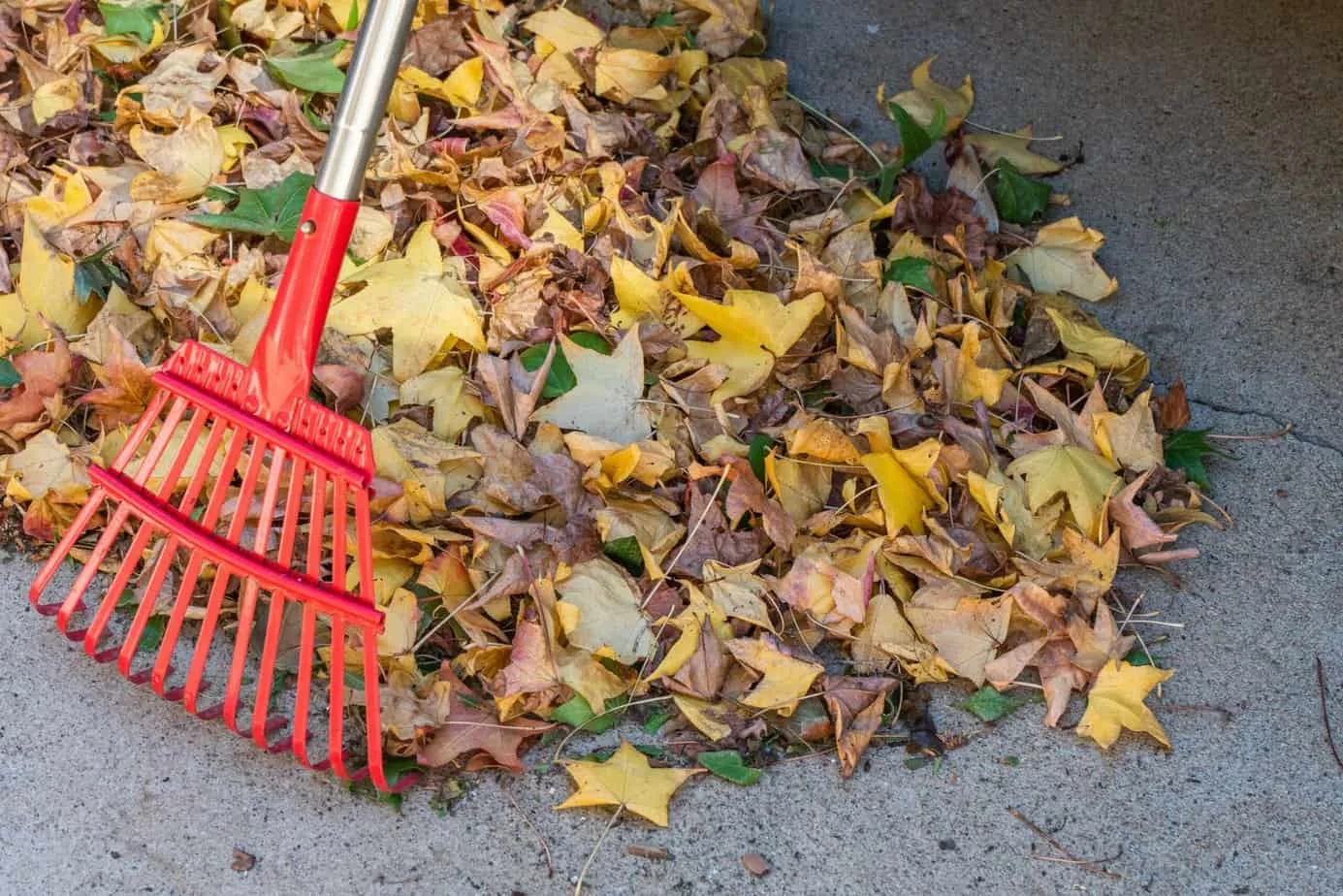My favorite season is Fall! I love the pumpkins, the colorful autumn leaves, and the cooler weather. While I did not grow up in East Texas, after living here for four autumns now, I am constantly asking myself the question “should I rake the leaves out of my yard this fall?” The answers are varied. Some of my neighbors bag up every last leaf and put the plastic bags on the corner for the trash company to take them to the landfill. This somehow seems like hard work and kind of backwards to me, but why is it the popular choice? I guess it is great exercise, but who really has time for that? Raking leaves seems like the worst thing I could possibly do, so I did a little research. Could leaf litter be good for a lawn’s health? What is the best way to deal with dead leaves and have a healthy lawn when Spring comes.

contains affiliate links Photo by Seth Doyle on Unsplash
The good news is that environmental experts have been thinking about this for a long time. As it turns out, a thick layer of leaves might actually be good for lawn maintenance.
The following article comes from the NWF press release “To Leave (the Leaves) or not to Leave: Survey finds Most People Open to Leaving Leaves to Benefit Wildlife.” (shared with permission)
To Leave (the Leaves) or not to Leave: Survey finds Most People Open to Leaving Leaves to Benefit Wildlife
A National Wildlife Federation survey found that most people (72 percent) know that fallen leaves and leaf layers are beneficial to wildlife and biodiversity, yet only 25 percent are leaving their leaves where they fall. Thankfully, 82 percent of people are open to leaving leaves to benefit wildlife in the future.
The inaugural Leave the Leaves Report celebrates the start of Leave the Leaves Month this October by surveying nearly 1,200 people to better understand behaviors and sentiments toward Autumn leaves.
“The Leave the Leaves Report gives an inside look into what people think about leaving the leaves and what they’re doing, or not doing, with those leaves. We’re seeing the majority of people removing their leaves with only a small handful using the waste for other purposes such as compost or mulch,” said David Mizejewski, naturalist for the National Wildlife Federation. “This tells us there’s an opportunity to educate the public about how fallen leaves can still benefit wildlife and the garden no matter if you remove them from your yard or leave them be.”
Survey results indicate that 51 percent of people who rake, remove or leaf blow their leaves are throwing them away, with 14 percent disposing of 10 bags or more of leaves per year.
According to the U.S. Environmental Protection Agency, leaves and other yard debris account for more than 13 percent of the nation’s solid waste. Without enough oxygen to decompose, this organic matter releases methane gas, which is more than 25 times more potent than carbon dioxide in trapping heat in the atmosphere.
Many wildlife species also use the leaf layer as their primary habitat. In the case of moths, 94 percent of species rely on the leaf layer to complete their life cycle. The caterpillars find cover under leaves, emerging as adults the next spring. The vast majority of our backyard birds rely on those butterfly and moth caterpillars as the primary food source for their young during nesting season. If you remove all of the fallen leaves, there will be fewer of these insects in and around the yard and likely fewer birds, too.
When considering why people continue to rake, leaf blow, remove or collect Autumn leaves despite knowing the benefits, the report found that some (21 percent) are concerned with leaves smothering or ruining their lawn. For others (36 percent), they’re required to remove their leaves by either a homeowner’s association and/or city and municipality ordinances. Meaning, they couldn’t leave their leaves even if they wanted to.
But for the 43 percent who have no concerns or requirements with leaving leaves, they may welcome the break from yet another fall chore and help wildlife thrive in the process.
Photo by Wendell Shinn on Unsplash
“Leaving the leaves is so much more than a debate about raking vs. not raking. It’s about how we as individuals can impact wildlife right at home through gardening and other outdoor maintenance practices,” said Mary Phillips, head of Certified Wildlife Habitat and Garden for Wildlife programs. “Creating and enhancing garden habitat continues throughout the year with potential for significant impact in the off seasons as we prepare for current and future wildlife generations. Small changes, like leaving the leaves, are easy ways to directly benefit biodiversity and the environment right at home.”
The Leave the Leaves Report surveyed 1,188 people between the ages of 18 and over 65 living across the United States. Highlights of the report can be found below:
-
36 percent of respondents are required to rake their leaves by either a homeowner’s association and/or city and municipality ordinances.
-
25 percent of people leave their leaves where they fall.
-
49 percent are using collected leaves for mulch, compost or both.
-
43 percent of those surveyed have no concerns about leaving leaves in their yard.
-
21 percent are worried about fallen leaves smothering or ruining their lawn.
-
25 percent remove their leaves because they don’t like the way fallen leaves look in the yard.
-
14 percent of those surveyed dispose of more than 10 bags of leaves per year, with 23 percent disposing between four to six per year.
-
72 percent of respondents know that fallen leaves and the leaf layer are beneficial to wildlife and biodiversity.
-
82 percent of people are open to leaving the leaves to benefit wildlife.
Interesting, right?
I worked out getting rid of the leaves last fall and it was only me in our house that was really passionate about cleaning up our yard. We have three massive trees that dump leaves in our front yard each year, and pine trees in the back that drop pine needles. It’s a lot to deal with, and I for sure am not bagging all those billions of leaves up by myself!
Say I don’t want to just leave my leaves, what are my other options?
- Use a leaf blower to blow the leaves away from your house every few days. Bugs and critters like to live under the leaves, but leaving them close to your house could make it easier for them to come inside. If you gently blow them away from your house into your yard, you are still giving them a place to live but maybe not so close to where you live. (Note: don’t be a jerk and blow your leaves into the street or neighbor’s yard!)
- Mow the leaves. Using your lawn mower to chop the leaves helps protect root systems, moisture, and provides nitrogen and organic matter that your grass needs and will thrive on. Does that help bugs and wildlife? More than just bagging up the leaves and sending them off to the landfill, but not nearly as great as just leaving the leaves for everything to hide under. Insects will still love the leaf mulch for food and a place to live. Mulched leaves can also be transported to other parts of the yard or garden beds to spread the love and provide insulation for plants during the winter. Check out this mulching mower if you have excessive leaf matter.
- Throw whole or mulched leaves in the compost pile or compost bin.
- If you MUST rake your leaves (because you have a Homeowner’s Association who demands it and sharing this post did not help,) bag up the leaves and see if you can donate them. Some cities and counties have programs that will help with this and offer free mulch in return,, or you might could find a farmer or home owner with a vegetable garden who would love your leaves.
- Lastly, you could always burn your leaves – If you are totally overrun with leaves and must rake some to clear a walking path and you cannot find anyone who wants dry leaves, consider burning your leaves. Consult your county’s burn ban and restrictions, of course, but collecting leaf piles in the burn pit can be a great, eco-friendly way to get rid of tree leaves. I tend to think this is still a better solution than bagging up your piles of leaves and adding more work to the trash workers and adding plastic to the landfill.
Shop new arrivals at James Perse
What do you do with your fall leaves?
[web_stories_embed url=”https://www.gingercasa.com/web-stories/do-i-have-to-rake-the-leaves/” title=”Do I Have to Rake The Leaves?” poster=”https://www.gingercasa.com/wp-content/uploads/2023/10/cropped-wendell-shinn-xsAj4IwTYik-unsplash-scaled-1.jpg” width=”360″ height=”600″ align=”none”]


Becky
Thursday 5th of October 2023
We lived in a house in an HOA for 16 years that required us to rake the leaves in our front yard, so we always did. But, we never raked the leaves in our back yard and usually scattered the leaves from our front yard into our back yard. Everyone told us it would ruin the grass, but in all those years it never did. In fact, I think our grass was better for it. I had a garden, so in early spring I would rake what was left of the leaves (we lived in an area with a lot of snowfall) into the garden and till it into the soil to enrich it. It always seemed crazy to dump all those leaves into garbage bags headed for landfills.
Gena
Friday 6th of October 2023
I agree! I'm glad to hear that it worked well for you!